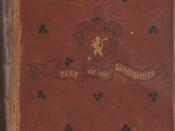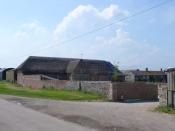From the beginning of the novel it is clear that tragedy will taint the life of Hardy's protagonist. As Hardy equates Hamlet and Tess from the start, we learn that he sees Tess as a virtuous victim and therefore as a tragic heroine. This is no surprise as a view often assimilated with the Victorian novel genre is fatalism and Hardy was known for his fatalistic outlook on life; this becomes apparent through Tess's own fate - undelivered letters, misunderstanding, and a string of unfortunate coincidences all lead to her tragic end. Each situation is a catalyst for the next, with episodes and characters carefully woven into a complex pattern and as part of this many events are explicitly prefigured. Hardy's extensive use of foreshadowing builds tension as well as making the family's decline seem inevitable, suggesting that Tess's fate is already sealed. She is dubbed the 'plaything' of the 'immortals' and it is obvious that the mark of the blood is upon her from the start.
This is symbolised at the club dance where Tess 'one of the white company' is the only one to have a 'red ribbon' in her hair. The certainty of loss and suffering become a key theme in the novel. However there are many factors that contribute to the tragic heroines downfall. Tess is only partly to blame for her own tragic decline. Powerful external pressures, such as social, biological, environmental and the supernatural, all drive her inexorably towards her cruel fate. Time and chance are also against Tess.
Social and biological pressures rank high on the tragic outcome of Hardy's heroine. In chapter one the Durbeyfields' discovery that they are scions of a once proud aristocratic family cause them to behave above their station, with Tess's father Jack (a drunkard and idle spendthrift)...



Tip
One idea would be look at literature.com, get the best tips
0 out of 0 people found this comment useful.